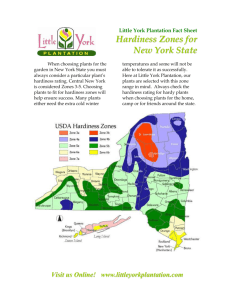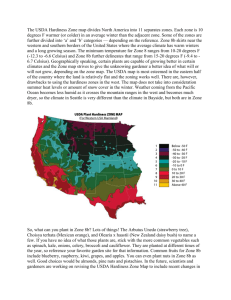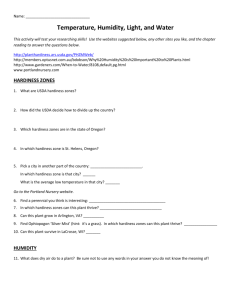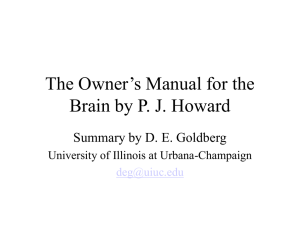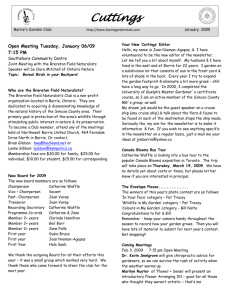Stress, hardiness & symptoms in Bosnia deployed soldiers
advertisement
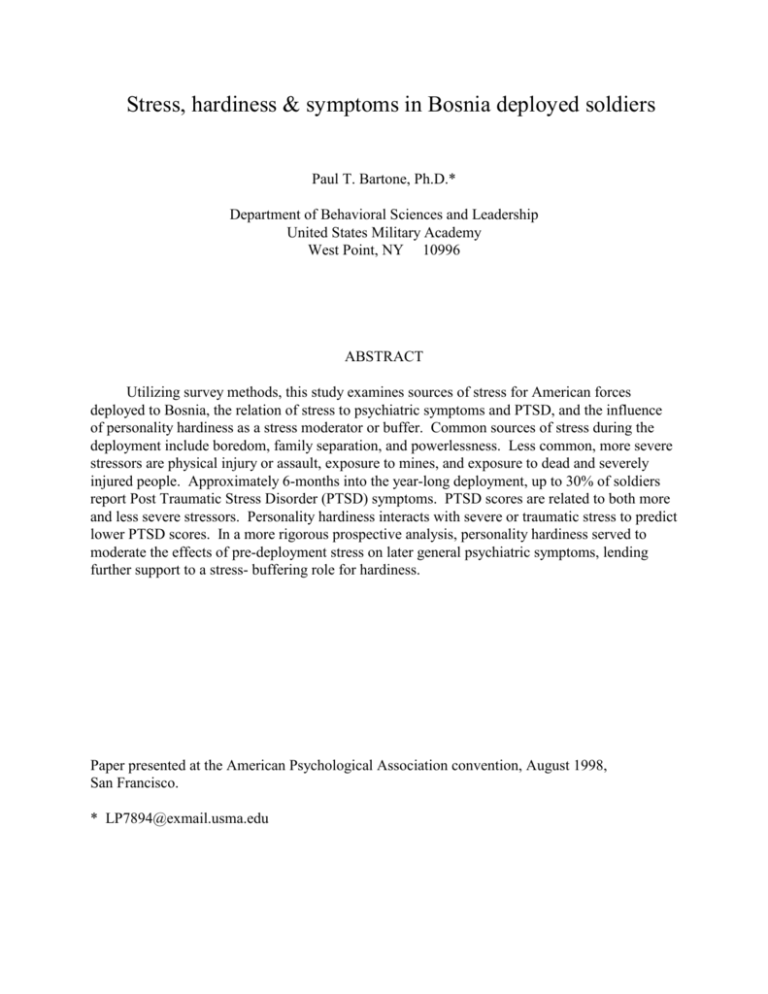
Stress, hardiness & symptoms in Bosnia deployed soldiers Paul T. Bartone, Ph.D.* Department of Behavioral Sciences and Leadership United States Military Academy West Point, NY 10996 ABSTRACT Utilizing survey methods, this study examines sources of stress for American forces deployed to Bosnia, the relation of stress to psychiatric symptoms and PTSD, and the influence of personality hardiness as a stress moderator or buffer. Common sources of stress during the deployment include boredom, family separation, and powerlessness. Less common, more severe stressors are physical injury or assault, exposure to mines, and exposure to dead and severely injured people. Approximately 6-months into the year-long deployment, up to 30% of soldiers report Post Traumatic Stress Disorder (PTSD) symptoms. PTSD scores are related to both more and less severe stressors. Personality hardiness interacts with severe or traumatic stress to predict lower PTSD scores. In a more rigorous prospective analysis, personality hardiness served to moderate the effects of pre-deployment stress on later general psychiatric symptoms, lending further support to a stress- buffering role for hardiness. Paper presented at the American Psychological Association convention, August 1998, San Francisco. * LP7894@exmail.usma.edu Stress, hardiness & symptoms in Bosnia deployed soldiers Paul T. Bartone, Ph.D. As the United States deploys an increasing number of soldiers to operations other than war, such as in Bosnia, it is important to understand the sources of stress on such missions, their health effects, and the factors that may contribute to continued good health of soldiers under stressful circumstances. To address these issues, survey data were collected on over 1,000 soldiers 6months after they deployed for what was to be a year-long mission of peacekeeping in the former Yugoslavia. This “mid-deployment” survey listed 65 potential daily stressors. Total stress exposure scores were created by summing responses to these stressor items. In addition, a list of 16 more extreme (traumatic) events was included. A traumatic stress exposure index was likewise created by summing responses to these items. Two separate regression models were tested, examining the influence of these two types of stressors on reported Post-Traumatic Stress Disorder (PTSD). PTSD was assessed by means of a 17-item checklist based directly on DSM-IV criteria (Bartone, Vaitkus & Adler, 1993). Personality hardiness was entered into both regression models, both as an independent predictor and as an interaction term with stress. Hardiness was measured with a short, 15-item scale that includes positively- and negatively-keyed items covering three hardiness facets of commitment, control and challenge (Bartone, 1995). This scale has an overall Cronbach’s alpha of .83 (for the facets, commitment .77; control .71; challenge .70). Personality hardiness has been identified as a significant moderator of stress in a variety of occupational groups (e.g., Bartone, 1989; Contrada, 1989; Kobasa, Maddi & Kahn, 1982; Roth et. al, 1989; Wiebe, 1991). Conceptually, “hardiness” is an individual differences variable that develops early in life and is reasonably stable over time, though amenable to change under certain conditions (Maddi & Kobasa, 1984). Hardy persons have a high sense of life and work commitment, greater sense of control, and are more open to change and challenges in life. In military groups, hardiness has been identified as a significant moderator of combat exposure stress in US Gulf War soldiers (Bartone, 1993). When responses on the PTSD scale are scored according to diagnostic criteria of DSM-IV, 8% to 30% of the samples show a pattern of symptoms consistent with a PTSD diagnosis (8% if more extreme cut-off is used, i.e., symptom is counted as “present”only if respondent reports experiencing it “often” during the past month; 30% if less exteme cut-off is used, i.e., symptom is counted as present if experienced “sometimes” during the past month). Regression analysis found a main effect for daily stressors on total PTSD scores, but no effects for hardiness (R2 = .27, p < .0001). A second regression (Table 1) examining more extreme or traumatic stressors found a main effect for stress on PTSD scores, and also a significant stress X hardiness interaction effect. The interaction effect shows that high hardy soldiers show less PTSD under high stress conditions than do low hardiness soldiers. Stressors correlating most highly with PTSD include family concerns and problems, problems with coworkers, isolation and boredom. Major stressors correlating with PTSD include being assaulted, witnessing an explosion, and witnessing serious injury or death. Table 1: Traumatic Event Exposure (mid-deploy) Predicts PTSD Symptoms ________________________________________________________ Predictor Beta Tot. Trauma .45 3.1 .002 -.45 -1.9 .05 Hardy X Trauma T p< ________________________________________________________ Multiple Regression (direct entry method) Model: F(3,1007) = 53.9, p<.0001 Multiple R .37 R Square = .14 N=1,010 U.S. Army personnel deployed to Bosnia-Croatia (June, 1996) Data on pre-deployment stressors were also available for a sub-group (N=103) of soldiers in the mid-deployment sample. This made it possible to examine the effects of earlier stress on later reported symptoms (Bartone et. al., 1989), and the possible moderating role of hardiness. Using (direct entry) regression, results showed that stress exposure in the pre-deployment period predicts later symptoms (using a 20-item psychiatric symptoms scale; Bartone et. al, 1989). Also, hardiness again interacts with exposure to predict (fewer) symptoms (Table 2). Other analyses found that pre-deployment stress predicts later depression as well, but not as strongly as it does symptoms. Table 2: Pre-deployment Stress & Hardiness Predict Later General Symptoms ________________________________________________________ Predictor Stress Stress X Hardy Beta T .84 3.8 -.64 -2.9 p< .0002 .004 ________________________________________________________ Multiple Regression (direct entry method) Model: F(2, 99) = 8.2, p<.0005 Multiple R .38 R Square = .14 N=103 US Army personnel deployed to Bosnia-Croatia (1996) These results on American soldiers 6-months into a year-long Bosnia deployment show clear and strong effects of stress exposure on PTSD symptomatology, for less severe and more extreme stressors. Hardiness interacts significantly with traumatic stress to predict PTSD. The prospective analyses show that stress exposure in the pre-deployment phase predicts depression and general symptoms later in time, at the mid-deployment phase, for U.S. Army soldiers deployed to Bosnia. Stress exposure at pre-deployment is more strongly related to later symptoms than to depression. Also, personality hardiness interacts with stress exposure to further predict symptoms, but not depression. These findings lend support to a stress buffering role for hardiness, where soldiers who are high in hardiness are more resilient and healthy under high stress conditions. Results also suggest soldiers tend to express psychological stress in terms of somatic complaints and symptoms, moreso than depression symptoms. This accords with recent studies showing long-term physical health effects of war stress (Elder et. al., 1997), and supports the view that psychological stress plays an important role in the emergence of symptoms in soldiers following military operations. References Bartone, P.T. (I 989). Predictors of stress-related illness in city bus drivers. J. of Occupational Medicine, 3 1. 657-663. Bartone, P.T. (June, 1993). Psychosocial predictors of soldier adjustment to combat stress. Paper presented at the Third European Conference on Traumatic Stress, Bergen, Norway. Bartone, P.T. (July, 1995). A short hardiness scale. Paper presented at the Annual Convention of the American Psychological Society, New York. Bartone, P.T., Ursano, R.J., Wright. K.W. & Ingraham, L.H. (1989). The impact of a military air disaster on the health of assistance workers: A prospective study. J- of Nervous and Mental Disease, 177, 317-328. Bartone, P.T., Vaitkus, M.A. & Adler, A.B. (June, 1994). Assessing Post Traumatic Stress Disorder and PTSD symptomatology in U.S. Army personnel. Presented at the 30th international Congress on Military Medicine, Augsburg, Germany. Contrada, R.J. (1989). Type A behavior, personality hardiness, and cardiovascular responses to stress. J. of Personality and Social Psychology, 57, 895-903. Elder, G.H., Shanahan, M.J. & Clipp, E.C. (1997). Linking combat and physical health: the legacy of World War II in men's lives. American Journal of Psychiatry, 154, 330-336. Kobasa, S.C. (1979). Stressful life events, personality, and health: An inquiry into hardiness. J. of Personality and Social Psychology. 37, 1 -1 1. Kobasa, S.C. & Maddi, S.R. (1977). Existential personality theory. In R. Corsini (Ed.), Existential Personality Theories, Itasca, IL: Peacock. Kobasa, S.C., Maddi, S.R., & Kahn, S. (1982) Hardiness and health: A prospective study. J. of Personality & Social Psychology, 42, 168-177. Maddi, S.R. & Kobasa, S.C. (1984). The Hardy Executiye. Homewood, IL: Dow Jones-Irwin. Roth, D.L., Wiebe, D.J., Fillingim, R.B. & Shay, K.A. (1989). Life events, fitness, hardiness, and health: A simultaneous analysis of proposed stress-resistance effects. J. of Personalily and Social Psychology, 57, 136-142. Wiebe, D.J. (1991). Hardiness and stress moderation: A test of proposed mechanisms. J. of Personalily and Social Psychology, 60, 89-99. Table 1: Traumatic Event Exposure (mid-deploy) Predicts PTSD Symptoms ________________________________________________________ Predictor Beta T p< Tot. Trauma .45 3.1 .002 Hardy X Trauma -.45 -1.9 .05 ________________________________________________________ Multiple Regression (direct entry method) Model: F(3,1007) = 53.9, p<.0001 Multiple R= .37 R Square = .14 N=1,010 U.S. Army personnel deployed to Bosnia-Croatia (June, 1996) Table 2: Pre-deployment Stress & Hardiness Predict Later General Symptoms ________________________________________________________ Predictor Beta T p< Stress .84 3.8 .0002 Stress X Hardy -.64 -2.9 .004 ________________________________________________________ Multiple Regression (direct entry method) Model: F(2, 99) = 8.2, p<.0005 Multiple R= .38 R Square = .14 N=103 US Army personnel deployed to Bosnia-Croatia (1996)
